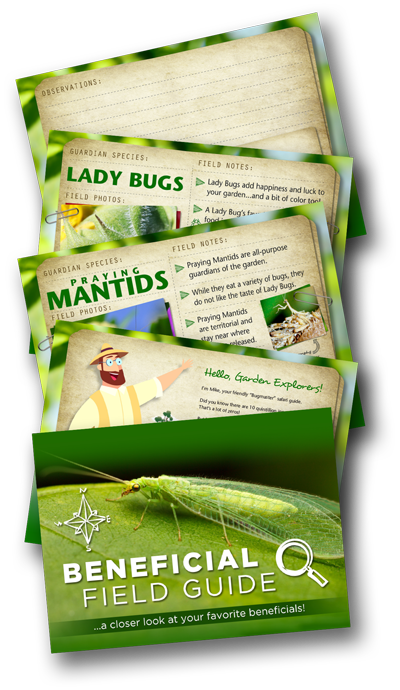There’s a New Sheriff in Town
Perhaps the most common question we receive in Garden Centers around the country about Beneficial Nematodes is, “Does it work on …..?”
YES!
As in all of nature, the bug world contains both predators and prey. As gardeners, we tend to think of bugs as bad guys or good guys. There are the bugs that eat the fruits of our labor, and there are beneficial bugs that eat those bugs! Since much of the life cycle of harmful bugs happens under the cover of darkness, beneath the soil, we like to think of Beneficial Nematodes as the New Sheriff in town! If there’s a larva problem in the soil, nematodes are Nature’s way of keeping infestations in balance… keeping the “good guys” safe from the pesky beetles and voracious plant -eating enemies of your garden.
Most gardening enthusiasts walk into their local nursery with a specific problem to solve – aphids on their roses, struggling tomato plants with knots on their roots, clouds of fungus gnats, or a shovelful of grubs.
So much of a gardener’s battle takes place beneath the soil – out of view from even the most careful plant parent.
Beneficial Nematodes can come to the rescue, putting a stop to the harmful insects right where they begin.
Stop Garden Pest Crimes with Beneficial Nematodes
List of Pests controlled by Beneficial Nematodes:
- Yellow Fever Mosquito: A primary carrier of such diseases as dengue fever, chikungunya, Zika fever, and yellow fever, they feed during daylight, spreading diseases.
- Treehole Mosquito: These pests are known to carry various arboviruses that may infect both humans and pets.
- German Cockroach: German cockroaches contaminate food and surfaces in homes, also triggering allergic reactions and asthma in adults and children.
- Formosan Subterranean Termite: Although not a particular health risk, this invasive species causes hazardous structural damage to buildings.
- Winter Mosquito & Northern House Mosquito: These mosquitoes are known carriers of diseases such as West Nile virus and various types of encephalitis, posing a health risk to both humans and animals.
- Mexican Fruit Fly: Bothersome to pets and people and destructive to crops, these invasive flies replicate and destroy entire orchards in a season.
- House Fly: House flies can carry numerous diseases as they move between waste and human foods. They can spread diseases like food poisoning and dysentery to humans and pets.
- Japanese Beetle: These beetles are particularly harmful in that they feed on 300 different kinds of agricultural and ornamental plants. They are highly destructive as they feed on every part of the plant, beginning with the roots, then moving on to damage lawns, flowers, and fruit.
- Fire Ant: Working together aggressively, these ants can deliver multiple painful bites and stings that may cause allergic reactions in both humans and animals. Invading homes and yards, fire ants are annoying and hazardous.
- Flea: Fleas are parasites that bite humans and pets, causing itching and allergic reactions. They can also transmit diseases like plague and typhus, and parasites like tapeworms, to both humans and pets.
- Western yellowjacket: The painful stings of these yellowjackets may also induce allergic reactions. Attracted to human food, they damage homes and yards by nesting there.
We’re sharing this information because we want people to know that they don’t have to simply put up with harmful bugs – there is a solution, provided by Mother Nature. If we work with the earth, we can protect ourselves, our pets, and our planet from both parasites and pesticides.
If you’re curious about the rest of the pests whose life cycle is interrupted by these Beneficial Nematodes, here they are from A to Z below!
- Acanthoscelides obtectus (bean weevil)
- Acheta assimilis (field cricket)
- Acheta domescica (house cricket)
- Achroia grisella (lesser wax moth)
- Acrolepia assectella (leek moth)
- Acromyrmex octospinosus
- Aedes aegypti (yellow fever mosquito)
- Aedes sierrensis (treehole mosquito)
- Aegorhinus phaleratus
- Aethina tumida(small hive beetle)
- Agriotes lineatus (lined click beetle)
- Agrotis ipsilon (black cutworm)
- Agrotis segetum (turnip moth)
- Agrotis subterranea (granulate cutworm)
- Alabama argillacea (cotton leafworm)
- Alsophila pometaria (fall cankerworm)
- Alticini spp (flea beetle)
- Amphitornus coloradus (striped slant-face)
- Anabrus simplex (Mormon cricket)
- Anarsia lineatella (peach twig borer)
- Anastrepha ludens (Mexican fruit fly)
- Anax junius (green darner)
- Antheraea pernyi (Chinese tussar moth)
- Anthonomus grandis (boll weevil)
- Anthonomus vestitus (Peruvian boll weevil)
- Aramyelois transitella (navel orangeworm)
- Argyrotaenia citiana (apple skinworm)
- Athalia proxima (mustard sawfly)
- Athalia rosae (turnip sawfly)
- Aubacophora foveicollis
- Aulocara elliotti (bigheaded cricket)
- Barathra brassicae
- Barias spp
- Baris caeralesceus
- Billbugs
- Blatella germanica (German cockroach)
- Blissus leucopterus insularis (southern chinch bug)
- Bombyx mori (silkworm)
- Brachycerus undatus (garlic weevil)
- Bradysia spp (fungus gnat)
- Brevicoryne brassicae (cabbage aphid)
- Bruneria brunnea (Bruner’s grasshopper)
- Caliroa aethiops (rose sawfly)
- Camponotus spp
- Campsomeris dorsata
- Carpophilus hemipterus (dried-fruit beetle)
- Carpophilus humeralis (pineapple beetle)
- Carpophilus multilatus
- Carpophilus obsoletus
- Cassida rubiginosa (thistle tortoise beetle)
- Ceutorhynchus assimilis (cabbage seed pod weevil)
- Chaetocnema confinis (sweetpotato flea beetle)
- Chilo suppressalis (rice striped stem borer)
- Chlorida festiva (longhorned beetle)
- Choristoneura fumiferana (eastern spruce budworm)
- Choristoneura pinus (jack pine budworm)
- Choristoneura rosaceana (oblique-banded leafroller)
- Chrysopa collaris
- Chrysoteuchia topiaria(cranberry girldler)
- Cirphis compta (army-worm)
- Coleomegylla spp
- Conoderus falli (southern potato wireworm)
- Coptotermes formosanus (Formosan subterranean termite)
- Corythaica cyathicollis (lace bug)
- Cosmopolites sordidus (banana root borer)
- Culex pipiens (northern house mosquito)
- Culiseta inornata (winter mosquito)
- Curculio caryae (pecan weevil)
- Curculionidae napae
- Curculionidae picitarsis (winter stem weevil)
- Curculionidae quadridens (bark beetle)
- Curculionidae pleurostigma (turnip gall weevil)
- Cylas formicarius(sweetpotato weevil)
- Dasyneura brassicae (brassica pod midge)
- Delia radicum (cabbage root maggot)
- Dendroctonus frontalis (southern pine beetle)
- Dendrolimus pini (pine tree lappet)
- Dermacentor marginatus
- Dermestes vulpinus (leather beetle)
- Diabrotica balteata (banded cucumber beetle)
- Diabrotica virgifera virgifera(corn rootworm)
- Diacrisia obliqua
- Diaphania hyalinata (melonworm moth)
- Diaprepes abbreviata (diaprepes root weevil)
- Diatraea saccharalis (sugarcane borer)
- Dicyphus famelicus
- Dinoderus minutus (bamboo borer)
- Diprion similis (introduced pine sawfly)
- Dysdercus cingulatus
- Dysdercus peruvianus
- Eburia octomaculata
- Ectinohoplia rufipes
- Ectinus dahuricus
- Elasmopalpus lignosellus (lesser cornstalk borer)
- Ephestia elutella (tobacco moth)
- Ephestia kuehniella (Mediterranean flour moth)
- Epilachna varivestis (Mexican bean beetle)
- Epinotia aporema
- Estigeme acrea (saltmarsh caterpillar)
- Euxoa messoria (darksided cutworm)
- Fumibotys fumalis (mint root borer)
- Galleria mellonella (honeycomb moth)
- Glossina morsitans (Tsetse fly)
- Gnorimoschema operculella
- Graphognathus leucoloma (white fringed beetles)
- Graphognathus peregrinus
- Grapholitha molesta (peach moth)
- Gryllotalpa gryllotalpa (European mole cricket)
- Haptoncus luteolus
- Harrisina americana (grapeleaf skeletonizer)
- Heilipus latro
- Heliothis armigera (cotton bollworm)
- Heliothis virescens (tobacco budworm)
- Heliothis zea (corn earworm)
- Herse convolvuli
- Hexacolus guyanensis
- Hibernia defoliaria
- Hieroxestis subcervinella
- Hydraecia xanthenes (artichoke moth)
- Hylamorpha elegans
- Hylemya antiqua(onion maggot)
- Hylemya brassicae
- Hylemya platura (seedcorn maggot)
- Hylemya floralis (turnip root fly)
- Hylobius radicis (pine root collar weevil)
- Hypera postica (alfalfa weevil)
- Hyphantria cunea (fall webworm)
- Hyponomeuta malinellus
- Hypsipila grandella
- Laphygma frugiperda (fall army worm)
- Lasioderma serricorne (cigarette beetle or tobacco beetle)
- Laspeyresia pomonella (coddling moth)
- Lepttarsa decemlineataino (Colorado potato beetle)
- Leucinodes orbonalis (eggplant fruit and shoot borer)
- Lissorhoptrus oryzophilus (rice water weevil)
- Listroderus costirostris obliquus (vegetable weevil)
- Listronotus maculicollis(annual bluegrass weevil)
- Lyctus spp
- Macraspis tristis
- Macronoctua onusta(iris borer)
- Maculella noctuides
- Madoniella
- Malacosoma americanum (eastern tent caterpillar)
- Malacosoma neustria (lackey moth)
- Malacosoma californicum (western tent caterpillar)
- Mamestra oleracea
- Margarodes vitium
- Melanoplus bruneri (black heeled grasshopper)
- Melanoplus mexicanus
- Melanoplus packardii
- Meligethes spp
- Meloidogyne spp (root knot nematode)
- Melolontha hippocastani
- Mescinia peruella
- Mesocondyla condordalis
- Metagonistylum minense (Amazon fly)
- Metamasius hemipterus (silky cane weevil)
- Mocis punctularis
- Monochamus scutellatus (white-spotted sawyer)
- Musca domestica (house fly)
- Nasutitermes costalis
- Nauphoeta cinerea (speckled cockroach)
- Neocurtilla hexadactyla (northern mole cricket)
- Neodiprion americanus pratti (Virginia pine sawfly)
- Neodiprion lecontei (redheaded pine sawfly)
- Neodiprion sertifer (European pine sawfly)
- Nezara viridula (southern green stink bug)
- Noctuidae spp (including corn earworm)
- Oncopera fasciculata
- Operophthera brumata (winter moth)
- Opogona sacchari (banana moth)
- Orfelia spp (fungus gnat)
- Ostrinia nubilalis (European corn borer)
- Othnonius batesi
- Otiorhynchus ovatus (strawberry weevil)
- Otiorhynchus sulcatus(black vine weevil)
- Pantomorus spp
- Papilio demodocus (citrus swallowtail)
- Papilio machaon (Old World swallowtail)
- Papilio epiphorbas
- Parasa variabilis
- Passalus unicornis
- Paxillus puncticollis
- Pectinophora gossypiella (pink bollworm)
- Pennisetia marginata(raspberry crown borer)
- Peridroma saucia (variegated cutworm)
- Periplaneta americana (American cockroach)
- Phlebestroma quadrimaculatum
- Phryganidia californica (California oakworm)
- Phthia picta
- Phyllophaga(all types of white grubs)
- Phyllotreta spp (including the striped flea beetle)
- Pieris brassicae (cabbage white)
- Pieris rapae (small white)
- Pikonema alaskensis (yellowheaded spruce sawfly)
- Pissodes notatus
- Plagiodera versicolora (imported willow leaf beetle)
- Planococcus citri (citrus mealybug)
- Platyptilia carduidactyla (artichoke plume moth)
- Plectris aliena
- Plodia interpunctella (Indianmeal moth)
- Plusia gamma (silver-y moth)
- Plutella maculipennis (diamondback moth)
- Pococera atramentalis
- Polystes spp
- Popillia japonica(Japanese beetle)
- Poplar clearwing borer
- Porthetria dispar (gypsy moth)
- Premnotrypes vorax (potato weevil)
- Prionoxystus robiniae(carpenterworm)
- Pristiphora californica (California pear sawfly)
- Pristiphora erichsonii (larch sawfly)
- Prodenia eridania
- Protoparce sexta (tobacco hornworm)
- Pseudaletia separata
- Pseudaletia unipuncta (armyworm)
- Pseudexentera mali (pale apple leafroller moth)
- Pseudosphinx tetrio (plumeria caterpillar)
- Psylliodes chrysocephala (cabbage stem flea beetle)
- Pyrausta nubilalis
- Pyrausta nubilalis (European cornworm)
- Pyrrhocorus spp
- Rhagolites pomonella (apple maggot)
- Rhodnius prolixus
- Rhyacionia buoliana (pine shoot moth)
- Rhyacionia frustrana (Nantucket pine tip moth)
- Rhynchophorus cruentatus(palmetto weevil)
- Scirpophaga nivella (sugarcane top borer)
- Scolytus scolytus (large elm bark beetle)
- Scotogramma trifoli (clover cutworm)
- Selatosomus reichardti
- Sericesthis germinata
- Sesamia inferens (pink borer)
- Simulium vittatum
- Siphonapteraspp (flea)
- Sod webworm
- Solenopsis spp (fire ant)
- Sphex caliginosus
- Spodoptera frugiperda (fall armyworm)
- Spodoptera littoralis (cotton leafworm)
- Spodoptera litura (Oriental leafworm moth)
- Stelidota geminata (strawberry sap beetle)
- Symmerista albifrons
- Synanthedon exitios(peach tree borer)
- Synanthedon scitula(dogwood borer)
- Systena spp
- Tenebrio molitor (yellow mealworm beetle)
- Termes spp
- Tipulidae spp(crane fly)
- Triatoma infestans
- Tribolium castaneum (red flour beetle)
- Trichoplusia ni (cabbage looper)
- Tryporyza incertulas (yellow stem borer)
- Turpilia rigulosa
- Urbanus proteus (long-tailed skipper)
- Vespula pensylvanica (western yellowjacket)
- Vespula rufa atropilosa
- Vitacea polistiformis (grape root borer)
- Xylocopa mordax (carpenter bee)
- Yponeumata padella (orchard ermine)
- Zabrus tenebriodes
- Zinkenia fascialis
- Zophobas atratus (giant mealworm beetle)
Beneficial insects for the garden can be found at nurseries and garden centers near you. You can search for a store near you here.





